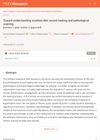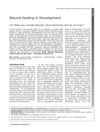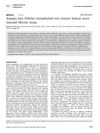Cutaneous Scarring: Pathophysiology, Molecular Mechanisms, and Scar Reduction Therapeutics
December 2011
in “
Journal of the American Academy of Dermatology
”
TLDR Understanding and targeting specific molecules can help reduce scarring and promote scar-free healing.
The document reviewed the pathophysiology and molecular mechanisms of cutaneous scarring, focusing on the phases of wound healing and the role of various cytokines and growth factors. It identified key molecular players such as TGFβ, interleukins, and the Wnt pathway, which influenced fibroblast activity and scarring. TGFβ1 and TGFβ2 promoted scarring, while TGFβ3 reduced it. Proinflammatory cytokines like IL-6 and IL-8 enhanced scarring, whereas IL-10 reduced it. The study suggested that modulating these pathways could lead to scar-reduction therapies. It also highlighted the potential of targeting hoxb13, Wnt signaling, EGR-1, PDGF, and osteopontin to reduce scarring, suggesting that understanding these mechanisms could lead to scar-free healing therapies.


